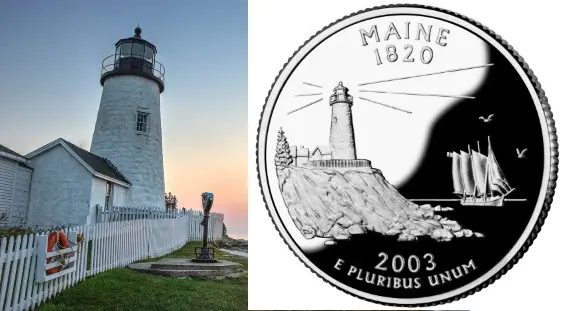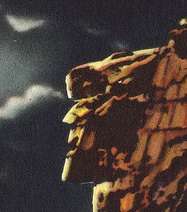From 1999 through 2008, the 50 State Quarter program released commemorative quarters with unique designs for each state. Half of all Americans collected them at least casually, making it the most successful commemorative coin program ever.
The U.S. mint released five each year, one quarter every 10 weeks. They came out in the same order that the states ratified the Constitution. In New England, that order meant Connecticut went first, then Massachusetts, New Hampshire, Rhode Island, Vermont and Maine.
Rules governed the choice of design. No live person, no state flag and no head-and-shoulder image of a dead person.
Each New England state responded with an image that you can visit today.
Here, then, are the six New England places that appear on the backs of quarters.
Charter Oak Tree
King Charles II in 1662 granted Connecticut a charter that allowed it to elect some of its own officials and make some of its own rules.
Charles’ successor, James II tried to combine the New England colonies with New York under a single Crown-appointed official, Edmund Andros. It didn’t go well.
In 1687, Andros and 60 soldiers met with the leaders of the Connecticut Colony in Hartford and heatedly insisted they turn over the charter. The colonists just as heatedly refused to give him the document, which lay on a table before them.
According to legend, something — a gust of wind, perhaps — blew out the candles that lit the meetinghouse. In the confusion, the charter disappeared. Someone hid it in the hollow of a large white oak tree, where the king’s men couldn’t find it.
The oak, of course, became the revered Charter Oak and a symbol of American independence. Already more than 300 years old in 1687, the Charter Oak fell to a violent storm on Aug. 21, 1856.
The Dominion of New England fell well before that. Andros dissolved the colonial governments, including Connecticut’s even without the charter. Two years later in 1689 Massachusetts colonists sent Andros packing. James II lost power, the charter came out of hiding and the colonies reverted to their previous form of government.
The Charter Oak still exists – as chairs in the Old Connecticut Statehouse and as artifacts currently on display at the Connecticut Historical Society.
On the corner of Charter Oak Avenue and Charter Oak Place stands a column with a globe and a descendant of the original tree. There may be as many as 100 such trees, as people had collected acorns before it fell. The Simsbury Historical Society, for example, planted a descendant of the Charter Oak in 1976 to commemorate the nation’s bicentennial.
A portrait of the Charter Oak, framed in wood from the tree itself, hangs in the Wadsworth Athenaeum in Hartford.
Pemaquid Point Lighthouse
Maine chose to honor its maritime heritage with an image of a windjammer sailing by Pemaquid Point Lighthouse on the back of its quarter.
President John Quincy Adams in 1827 commissioned Pemaquid Point Light in Bristol, Maine, about 60 miles north of Portland. The original lighthouse didn’t last long as builders mixed saltwater with the mortar mix. It had to be replaced in 1835, and the contract specified the use of fresh water in construction.
A storied lighthouse keeper, Marcus Hanna
, once staffed the lighthouse. He was the only person to ever receive a Medal of Honor for bravery during the Civil War and a Gold Lifesaving Medal for saving a life off Cape Elizabeth.
Today, the Bristol Parks and Recreation Department owns and operates the outbuildings surrounding the lighthouse as Pemaquid Point Lighthouse Park.
The vessel on the quarter is the Victory Chimes, a rare three-masted schooner. Moored in Rockland, Maine, the Victory Chimes sails up and down the coast on windjammer excursions.
Minute Man National Park
Massachusetts honors its historic role in the American Revolution by putting a famous statue of the Minute Man. The monument depicts a farmer who dropped his plow to fight at North Bridge in Concord, Mass., on April 19, 1775.
Today the statue stands guard at The Minuteman National Historical Park in Concord, where 500 militiamen defeated three companies of British troops.
In 1873 an unknown, 23-year-old college dropout was given the commission to create a monument to the Minute Man.
The 100th anniversary of the shot heard ‘round the world was approaching, and the citizens of Concord wanted to honor the farmers and tradesmen who battled professional British soldiers.
They decided to award the commission to Daniel Chester French, who had never executed a full-size statue. They had their reasons: His father was well-connected in town, and he had taken art lessons from Louisa May Alcott’s little sister, who vouched for his talent. French, of course, went on to design many famous works, including the Lincoln Memorial in Washington, D.C.
The Old Man of the Mountain
Alas, New Hampshire just can’t let go of the Old Man of the Mountain, though the mountain did. He tumbled to the ground on May 3, 2003, but his image still appears on license plates, state highway signs and the New Hampshire state quarter.
Before the Old Man went to his forever home, he was a series of five granite ledges hanging 1,200 feet above the floor of Franconia Notch. He measured 40 feet high from forehead to chin, and over the years he was held together by chains and patched up with cement, plastic, steel rods and turnbuckles.
At least he was already on the quarter when the U.S. Mint released it on Aug. 7, 2000.
For nearly 200 years, the Old Man of the Mountain attracted tourists and served as a proud symbol of New Hampshire.
New Hampshire native Daniel Webster perhaps best expressed what the Old Man meant to the state:
[U]p in the Mountains of New Hampshire, God Almighty has hung out a sign to show that there He makes men.
Claiborne Pell Newport Bridge
Watery Rhode Island chose to put the Claiborne Pell Newport Bridge, New England’s longest suspension bridge, on the back of its quarter. Since 1969 it has connected Newport with Jamestown. Today it costs 16 quarters to cross.
On a clear day, you can see the bridge from Gay Head Light in Martha’s Vineyard, the top floors of Providence’s tallest buildings and the parking lot of Stone Hill Marketplace in Johnston, R.I., 23 miles away.
Claiborne Pell served 36 years in the U.S. Senate from Rhode Island, and sponsored the bill to grant financial aid to college students in the form of Pell grants.
The quarter also depicts a vintage sailboat, as Rhode Island is nicknamed the sailing capital of the world. The nation’s smallest state, it has 400 miles of coastline and 100 beaches.
Camels Hump Mountain
Maple sugar is to Vermont as sailing is to Rhode Island. Well, maybe skiing is a more appropriate analogy, but Vermont went with maple sugaring on the back of its quarter.
The back of the quarter also features the Camels Hump Mountain in northern Vermont. It’s one of the tallest mountains in Vermont, and its distinctive profile makes it Vermont’s most recognized mountain.
The Camels Hump has had no less than a dozen names since Samuel de Champlain sailed down the lake that bears his name. De Champlain called it ‘Le Lion Couchant,’ meaning ‘the Resting Lion.’ Ira Allen called it the ‘Camel’s Rump.’ The Abenaki Indians called it ‘tahwahbodeay wadso.’
A forest preserve encloses the mountain, the summit of which philanthropist Joseph Battell donated to the state in 1905. By 1912, the Green Mountain Club built a trail between the mountain and Sterling Pond. Today the trail is a high point on the Long Trail system. The Green Mountain Club now pays a caretaker to make sure hikers respect the mountain’s fragile alpine tundra.
Images: Claiborne Pell Bridge By UpstateNYer – Own work, CC BY-SA 3.0, https://commons.wikimedia.org/w/index.php?curid=7548436; Pemaquid Point Lighthouse (featured image) By Tiger635 – Own work, CC BY-SA 3.0, https://commons.wikimedia.org/w/index.php?curid=31174599′ Pemaquid Point Lighthouse By WestportWiki – Own work, CC BY-SA 3.0, https://commons.wikimedia.org/w/index.php?curid=21041474












